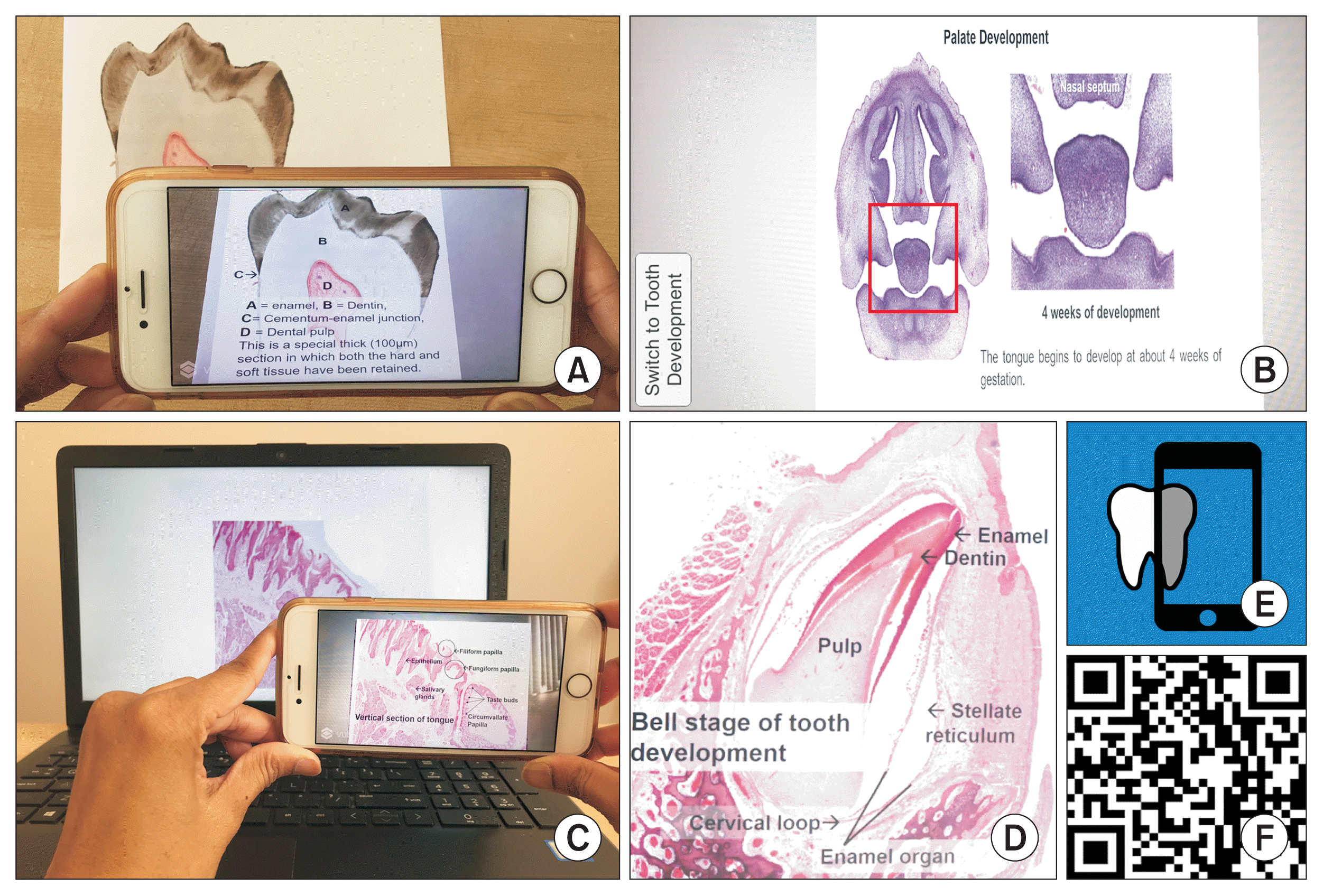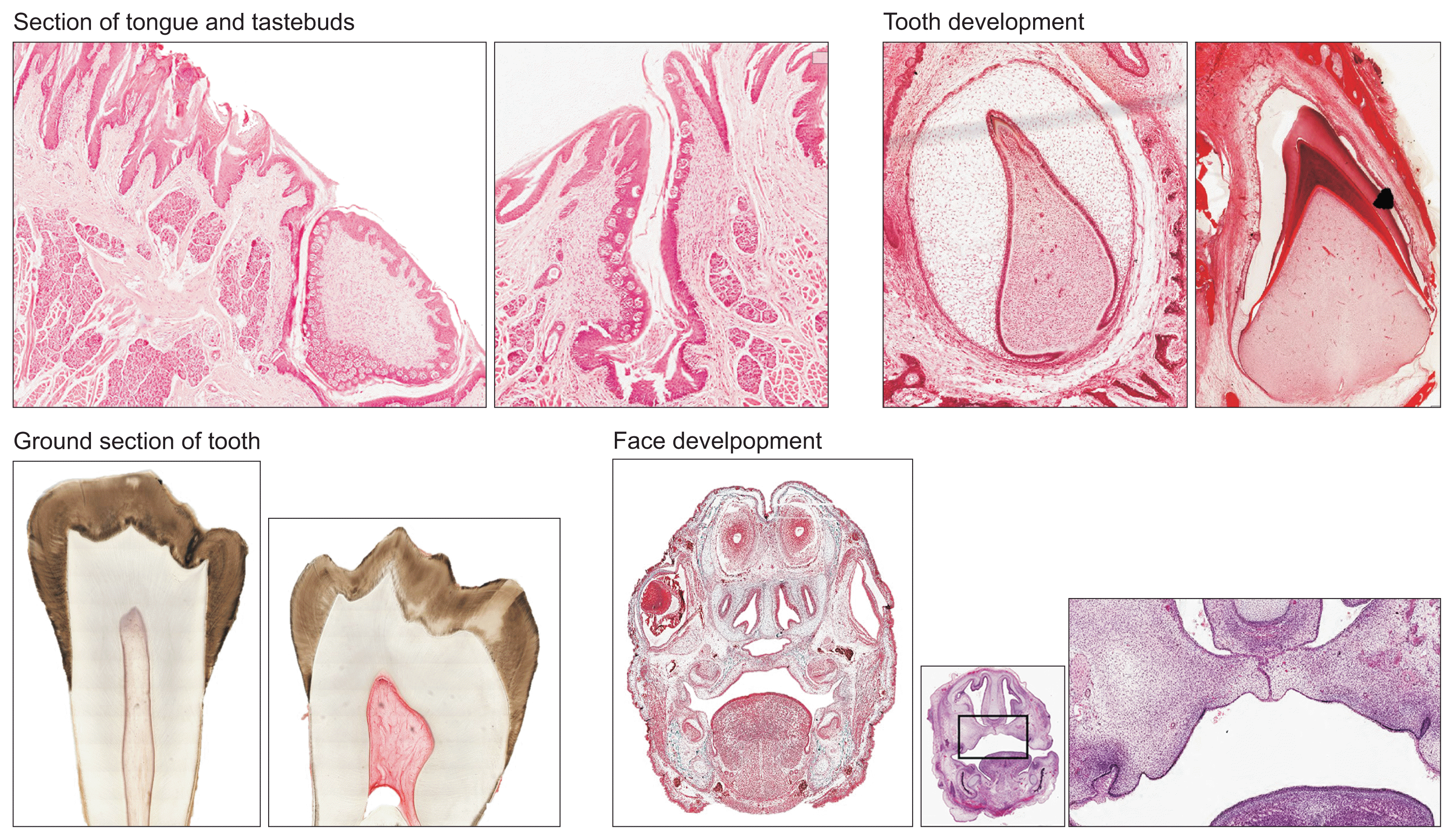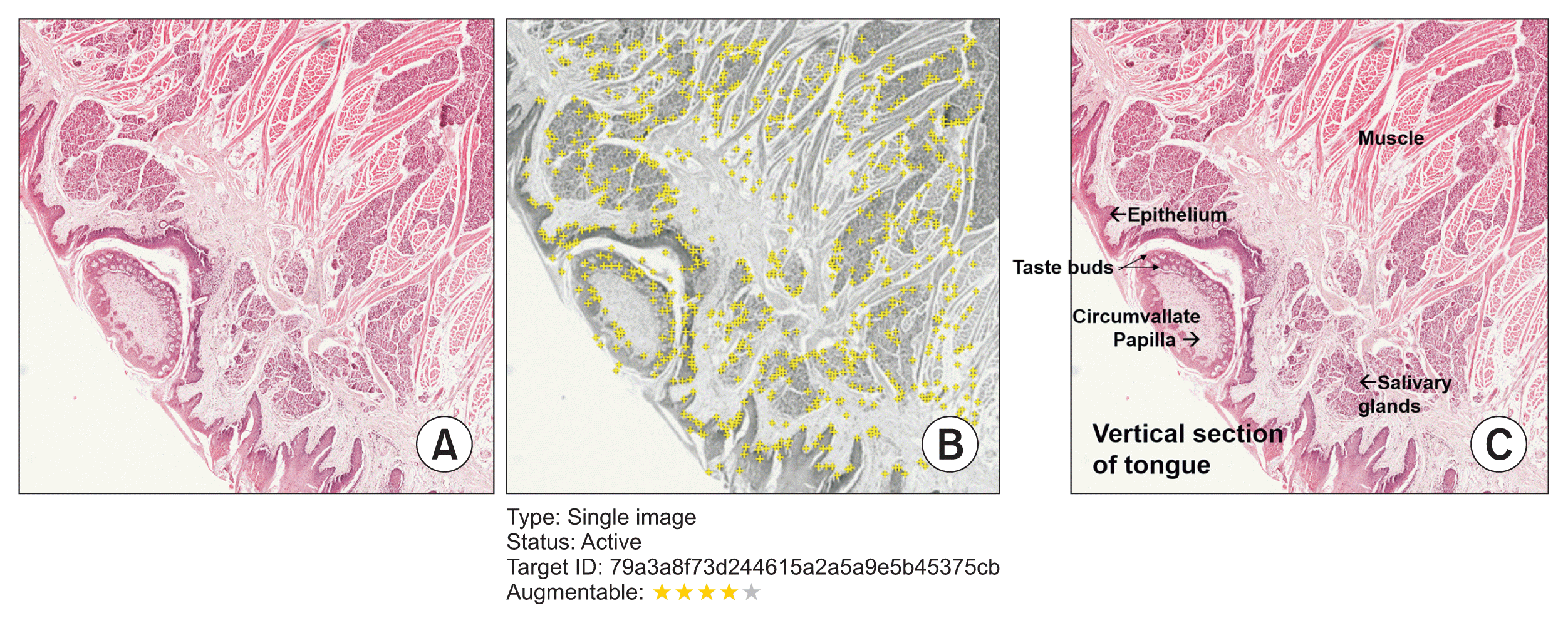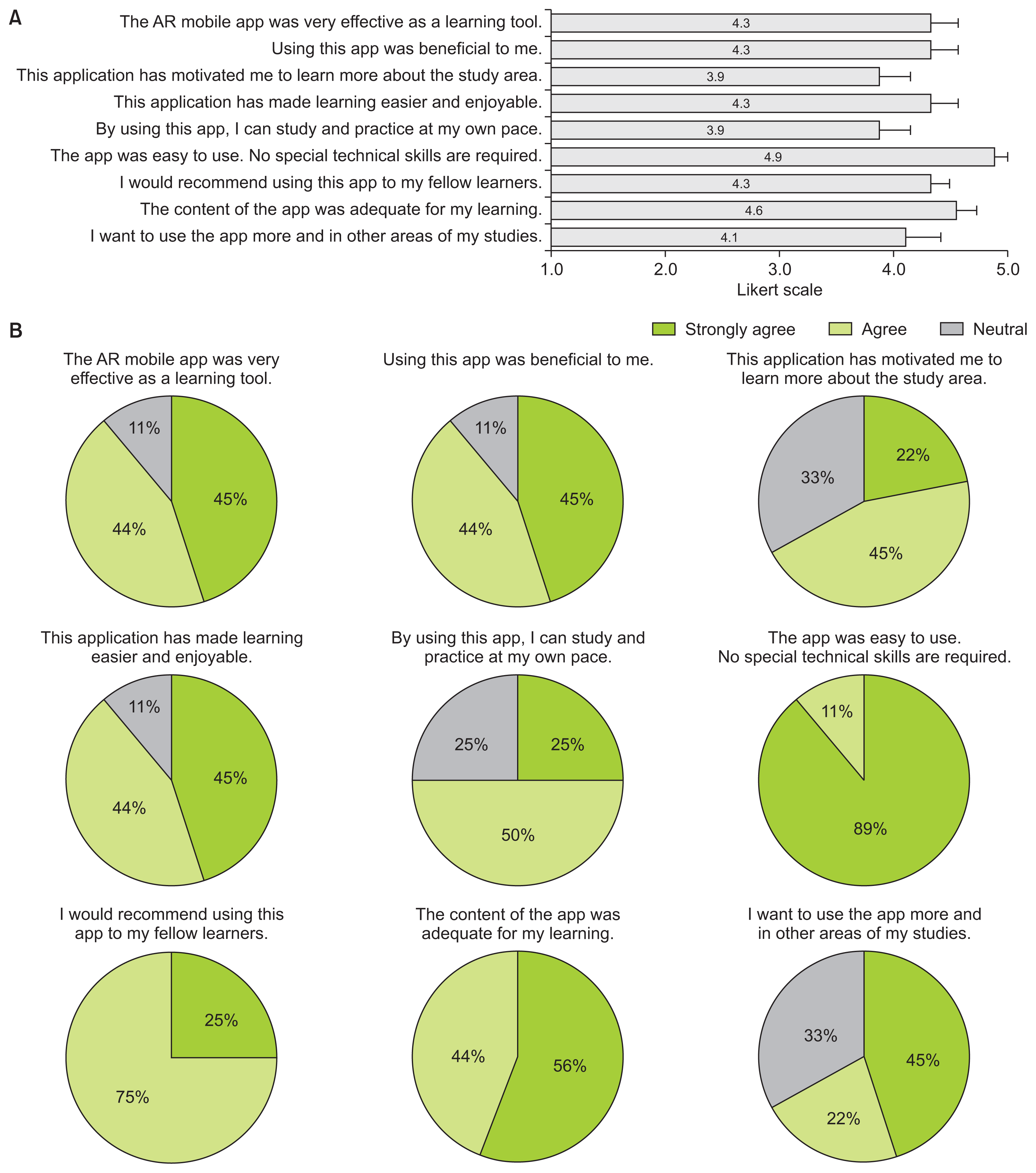Abstract
Objectives
The study of biological materials under a microscope is known as histology, which is one of the most challenging subjects for students. Our objective was to develop a learning tool that can reduce the extrinsic load of studying histology and make learning enjoyable and flexible. We used augmented reality (AR) to create a cellphone application called Dental AR. With Dental AR, students can use their cellphones as dynamic flashcards to hide or reveal the annotations of a histology slide. Our application enables students to study, practice, and self-test oral histology knowledge at their own pace.
Methods
We used Unity3D with Vuforia to develop Dental AR. To generate a set of target images, oral histology glass slides were scanned and converted to digital images. Annotated versions of the slides were used as output for the corresponding target images. To understand user experiences and satisfaction with Dental AR, first-year dentistry students were invited to complete an online survey.
Results
Dental AR was successfully developed and released on both the Apple and Google Play online app stores. The survey of dentistry students indicated overall satisfaction with Dental AR and willingness to use similar applications in other subjects.
Conclusions
Dental AR can be used for in-class activities, gamification, and providing students with practice questions to study and self-test outside the classroom. This application can be expanded in the future to incorporate more target images, videos, and interactive components to make learning histology less challenging and more enjoyable.
Histology, the knowledge of cellular and tissue structures at the microscopic level, is essential for dental, medical, and health sciences education. However, this branch of science is intrinsically challenging to learn [1,2]. Traditional histology teaching includes classroom lectures complemented with a microscopy laboratory component. Learners need to form an integrated mental schema of the location, structure, and function of the microscopic tissue components, which is a heavy cognitive load [1]. According to a student survey, the key features that make histology “difficult” include unfamiliar terminology, complexity of the subject, insufficient time, and inadequate photomicrographs [1].
Students studying dentistry and dental hygiene at the University of Alberta extensively study oral histology to understand the microanatomy and development of tooth and oral structures. Teaching oral histology at the School of Dentistry relies on PowerPoint presentations with images from textbooks, supplemented with light microscopy labs. One primary learning expectation is that the students recognize a given histological section and identify the underlying structural components. Students appreciate having access to more photomicrographs and practice labeling exercises to study on their own outside the class time. We created an alternate modality for students to reduce the cognitive load and time/location barriers of learning histology. We developed an augmented reality (AR) cellphone application called Dental AR (Figure 1) to help students develop mental models of cellular structures at their own pace.
Cognitive load theory explains how learning occurs and how educational technology can facilitate learning [3]. The information that we learn can be either primary or secondary [4]. Humans are evolutionarily programmed to acquire primary knowledge, such as speaking, without assistance. In contrast, secondary information requires learner’s conscious efforts and is aided by explicit instruction [5]. Learning to identify histological structures is an example of secondary information.
A critical part of learning is memory formation. Our cognitive system has a working memory with a limited capacity [5,6]. The learning load of working memory is affected by the underlying nature of the subject matter (intrinsic load) and how the topic is presented (extrinsic load). The intrinsic load is not readily changed for a given subject matter, but the learning process can be eased by changing the way the subject is presented (extrinsic load). The introduction of gamification using Kahoot in a histology course, for example, presented histology exceptionally well, stimulated learning and improved participants’ satisfaction [7]. With our Dental AR application, we hope to complement traditional teaching methods and reduce the extrinsic load by providing an alternate scaffold for learning histology.
Dental AR development was guided by Keller’s attention, relevance, confidence, and satisfaction (ARCS) model [8]. According to the ARCS model, students are more likely to engage with the study material if their attention is captured, their confidence is increased, they are satisfied with the material, and the subject’s relevance is apparent. To address the “attention” component, we developed Dental AR as a cellphone application, usable on any mobile device. Studies show that students regularly use their mobile devices for academic activities at the post-secondary level and consider these devices essential to their academic success [9]. Attention can also be gained by perceptual arousal, inquiry arousal, and variability [8,10]. Dental AR contains a collection of photomicrographs, videos, and audio that can be presented as questions to stimulate perceptual and inquiry arousal (Figures 1, 2).
When creating Dental AR, we implemented AR, a technology that incorporates digital data into the real-world space [11]. Users can use their smartphone camera to scan a target histology image and toggle to hide or display the image’s annotations (Figure 1). This allows students to use their cellphones as flashcards [12] and perform self-assessments of their oral histology knowledge. The application also includes videos that can assist in the formation of robust mental models. When an appropriate target image is scanned, a narrated video is displayed, explaining palate and tooth development mechanisms (Figure 1). Students can repeatedly interact with the material to improve their confidence. Dental AR allows students to test their knowledge in a just-in-time manner, building motivation through satisfaction [13].
The technical details of application development were previously described [12]. In brief, the School of Dentistry has a collection of histology glass slides for teaching oral histology using light microscopes. Representative slides were selected, scanned, and uploaded to a database to create target images (Figures 2, 3). An annotated copy of the same image was used as the output for the corresponding target image. Currently, Dental AR has a database of 33 different oral histology target images that include tooth structures, the developing tooth and palate, oral mucosa, cell layers, salivary glands, and other supporting oral structures (Figure 2).
Oral histology is currently taught to first-year dentistry students in an online format due to coronavirus disease 2019–related restrictions. Dental AR was introduced to these students in a virtual meeting, and they were encouraged to download the application. A set of practice questions prepared using the Dental AR target images was posted on the online course learning management system for the students to practice oral histology at their own pace, using their cellphones and Dental AR.
After the course, the students were invited by email to participate in an anonymous online survey to evaluate their acceptance, satisfaction, and feedback on improving Dental AR for the future. The online survey contained questions to be answered with Likert scale ratings and fields for descriptive comments.
The class of 32 students downloaded Dental AR when the app was introduced in an online synchronous session. Nine students completed the survey, corresponding to 28% of the class. Eight out of the nine participants (89%) either agreed or strongly agreed that Dental AR is an effective and beneficial learning tool, while 78% affirmed that Dental AR motivated them to learn more about the subject area. Furthermore, 89% of the participants thought that Dental AR made learning easier and enjoyable. All participants agreed that the application’s content was adequate for their learning, and they would recommend using Dental AR to their fellow learners. Two-thirds (67%) of the participants stated that they would like to use Dental AR or a similar application in other areas of their studies (Figure 4).
To better understand students’ experiences with Dental AR, we asked them to describe their overall experiences with the application. Some examples of participants’ comments include:
“It was very convenient to use as both a learning and a self-testing tool.”
“I found it really convenient to be able to view the histological structures on a slide using this app. I liked how easy and quickly I could see the structures over my phone. The labelling was clear and it was very quick and convenient.”
Recommendations on improving Dental AR in the future included expanding the application to other courses and subject areas:
Histology has always been a relatively unengaging and intrinsically challenging topic for health professional students. To reduce the extrinsic load of learning histology, Dental AR creates an alternate way to present histology to students.
Although the survey response rate was low, it is consistent with what is typically observed with surveys of this type, and students who completed the survey represented 28% of the entire cohort. According to the students, both the confidence and satisfaction components of Keller’s ARCS model were addressed using Dental AR, and this application was an effective supplement to their learning. One point of feedback from the students was that the app helped them study for only 10% of the exam questions. We hope to expand Dental AR by incorporating more target images and videos to cover more subject areas to address this concern.
The students at the School of Dentistry are required to have a computer, and all have a personal smartphone or mobile device; however, not all students are privileged to have access to this type of technology. Another possible pitfall of using this type of technology for learning is the potential for distraction by multifunctional technologies like smartphones. Interruptions by text messages, phone calls, or notifications can disrupt students’ attention and inhibit the formation of the mental models necessary for effective learning. Despite these limitations, the amalgamation of computers, AR, cellphones, and education improves student satisfaction, in-class participation [14], and academic performance [15,16]. We believe that Dental AR has a promising future in facilitating effective learning.
Acknowledgments
This project is funded by School of Dentistry Education Research Fund (SDERF), Educational Research and Scholarship Unit, University of Alberta.
We would like to acknowledge the following persons for helping us in the ethics application and administration of the student survey: Jacqueline Green (Research Assistant, Educational Research & Scholarship Unit; School of Dentistry, Faculty of Medicine and Dentistry, College of Health Sciences, University of Alberta) and Madison Howey (Research Assistant, Educational Research & Scholarship Unit; School of Dentistry, Faculty of Medicine and Dentistry, College of Health Sciences, University of Alberta).
References
1. Garcia M, Victory N, Navarro-Sempere A, Segovia Y. Students’ views on difficulties in learning histology. Anat Sci Educ. 2019; 12(5):541–9.

2. Johnson S, Purkiss J, Holaday L, Selvig D, Hortsch M. Learning histology: dental and medical students’ study strategies. Eur J Dent Educ. 2015; 19(2):65–73.

3. Sweller J, Ayres P, Kalyuga S. Cognitive load theory. New York (NY): Springer;2011.
4. Geary DC, Berch DB. Evolution and children’s cognitive and academic development. Geary D, Berch D, editors. Evolutionary perspectives on child development and education. Cham, Switzerland: Springer;2016. p. 217–49.

5. Sweller J. Cognitive load theory and educational technology. Educ Technol Res Dev. 2020; 68(1):1–16.

6. van Merrienboer JJ, Sweller J. Cognitive load theory in health professional education: design principles and strategies. Med Educ. 2010; 44(1):85–93.

7. Felszeghy S, Pasonen-Seppanen S, Koskela A, Nieminen P, Harkonen K, Paldanius K, et al. Using online game-based platforms to improve student performance and engagement in histology teaching. BMC Med Educ. 2019; 19(1):273.

8. Keller JM. Motivational design for learning and performance: the ARCS model approach. New York (NY): Springer;2010.
9. Dahlstrom E; Educause Center for Applied Research. ECAR study of undergraduate students and information technology 2012 [Internet]. Boulder (CO): Educause Center for Applied Research;2012. [cited 2022 April, 6]. Available from: https://library.educause.edu/resources/2012/9/ecar-study-of-undergraduate-students-and-information-technology-2012
.
10. Milman NB, Wessmiller J. Motivating the online learner using Keller’s ARCS model. Distance Learn. 2016; 13(2):67–71.
11. Vega Garzon JC, Magrini ML, Galembeck E. Using augmented reality to teach and learn biochemistry. Biochem Mol Biol Educ. 2017; 45(5):417–20.

12. Sharmin N, Chow AK. Augmented reality application to develop a learning tool for students: transforming cellphones into flashcards. Healthc Inform Res. 2020; 26(3):238–42.

13. Newby TJ, Stepich DA, Lehman JD, Russell JD, Ottenbreit-Leftwich AO. Educational technology for teaching and learning. 4th ed. Boston (MA): Pearson;2012.
14. Revell SM, McCurry MK. Engaging millennial learners: Effectiveness of personal response system technology with nursing students in small and large classrooms. J Nurs Educ. 2010; 49(5):272–5.

15. Janssen A, Shaw T, Goodyear P, Kerfoot BP, Bryce D. A little healthy competition: using mixed methods to pilot a team-based digital game for boosting medical student engagement with anatomy and histology content. BMC Med Educ. 2015; 15:173.

16. Thompson ME, Ford R, Webster A. Effectiveness of interactive, online games in learning neuroscience and students’ perception of the games as learning tools. A pre-experimental study. J Allied Health. 2011; 40(3):150–5.
Figure 1
Dental AR in action. Dental AR receives access to the device camera. When the camera is pointed at an image, the application detects the target image and replaces the target with the pre-defined output, the annotated version of the histology slide. The application detects target images equally well from paper printouts (A) and computer screens (C). (B) Dental AR also contains videos explaining tooth and palate development. (D) The output of a tooth development slide from the cellphone screen. (E) The logo of our AR application. (F) The QR code directs you to the app store to download Dental AR. AR: augmented reality.

Figure 2
Some representative target images used in Dental AR. The target image set of our application includes photomicrographs of teeth, oral structures, tooth and facial development, salivary glands, oral epithelium, and oral mucosa. AR: augmented reality.

Figure 3
Sample target image in the Vuforia database. Images are uploaded in the Vuforia database, where the photomicrographs are tested for their augmentability. The images in the Vuforia database are assigned a score on a scale of 1–5, which indicates how well the image can be detected by Unity3D. The figure shows an oral histology photomicrograph (A), scanning into the Vufroria database for augmentability (B) and the annotated output of the histology slide (C).

Figure 4
Students’ acceptance and satisfaction with the Dental AR application. Students were invited by email to participate in an anonymous online survey. The online survey contained questions with quantitative values. Nine students participated in the survey. Each question was scored on a scale from 1 to 5. (A) The mean score was calculated for each question. (B) The percent distribution of students’ agreement is shown for each question in the survey. AR: augmented reality.





 PDF
PDF Citation
Citation Print
Print



 XML Download
XML Download